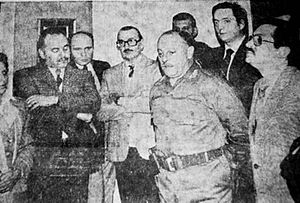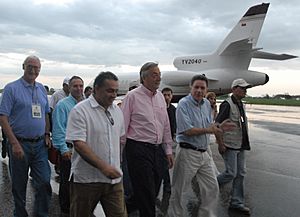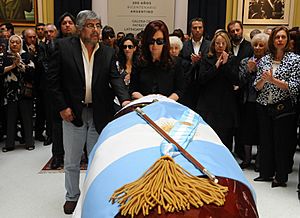Néstor Kirchner facts for kids
Quick facts for kids
Néstor Kirchner
|
|
|---|---|

Kirchner in 2005
|
|
| President of Argentina | |
| In office 25 May 2003 – 10 December 2007 |
|
| Vice President | Daniel Scioli |
| Preceded by | Eduardo Duhalde (interim) |
| Succeeded by | Cristina Fernández de Kirchner |
| First Gentleman of Argentina | |
| In role 10 December 2007 – 27 October 2010 |
|
| President | Cristina Fernández de Kirchner |
| Preceded by | Cristina Fernández de Kirchner (First Lady) |
| Succeeded by | Juliana Awada (First Lady, 2015) |
| Secretary General of UNASUR | |
| In office 4 May 2010 – 27 October 2010 |
|
| Preceded by | Office established |
| Succeeded by | María Emma Mejía Vélez |
| National Deputy | |
| In office 10 December 2009 – 27 October 2010 |
|
| Constituency | Buenos Aires |
| President of the Justicialist Party | |
| In office 11 November 2009 – 27 October 2010 |
|
| Preceded by | Daniel Scioli |
| Succeeded by | Daniel Scioli |
| In office 25 April 2008 – 29 June 2009 |
|
| Preceded by | Ramón Ruiz |
| Succeeded by | Daniel Scioli |
| Member of the Constitutional Convention | |
| In office 1 May 1994 – 22 August 1994 |
|
| Constituency | Santa Cruz |
| Governor of Santa Cruz | |
| In office 10 December 1991 – 25 May 2003 |
|
| Vice Governor | Eduardo Arnold (1991–1999) Héctor Icazuriaga (1999–2003) |
| Preceded by | Ricardo del Val |
| Succeeded by | Héctor Icazuriaga |
| Intendant of Río Gallegos | |
| In office 10 December 1987 – 10 December 1991 |
|
| Preceded by | Jorge Marcelo Cepernic |
| Succeeded by | Alfredo Anselmo Martínez |
| Personal details | |
| Born |
Néstor Carlos Kirchner
25 February 1950 Río Gallegos, Santa Cruz, Argentina |
| Died | 27 October 2010 (aged 60) El Calafate, Santa Cruz, Argentina |
| Resting place | Mausoleum of Néstor Kirchner, Río Gallegos |
| Political party | Justicialist Party |
| Spouse | |
| Children | 2, including Máximo |
| Alma mater | National University of La Plata |
| Profession | Lawyer |
| Signature |  |
Néstor Carlos Kirchner (25 February 1950 – 27 October 2010) was an Argentine lawyer and politician. He served as the President of Argentina from 2003 to 2007. Before that, he was the Governor of Santa Cruz Province from 1991 to 2003.
After his presidency, he became the Secretary General of UNASUR, a group of South American nations. He was also the First Gentleman when his wife, Cristina Fernández de Kirchner, became president. He led the Justicialist Party from 2008 to 2010. His political ideas were based on Peronism and Progressivism, and his approach was known as Kirchnerism.
Contents
Early Life and Political Beginnings
Néstor Kirchner was born on 25 February 1950, in Río Gallegos, Santa Cruz. His father was of German-Swiss descent, and his mother was of Croatian descent. He had two sisters, Alicia and María Cristina. When he was young, he had a condition called strabismus (crossed eyes) but chose not to have it treated.
In 1969, Kirchner moved to La Plata to study law at the National University of La Plata. During this time, Argentina faced a lot of political unrest. He joined a student political group called the University Federation for the National Revolution (FURN). He met Cristina Fernández in 1974, and they quickly fell in love. They got married after six months and both became lawyers.
After graduating, Néstor and Cristina returned to Patagonia and started their own law firm. They worked for banks and financial groups. Later, Argentina returned to democracy, and Kirchner became more involved in politics. He led a group within the local Justicialist Party (PJ).
In 1987, Kirchner ran for mayor of Río Gallegos and won by a very small number of votes. He then became a strong opponent of the governor, Ricardo del Val, who was removed from office in 1990 due to an economic crisis.
Governor of Santa Cruz Province
In 1991, Kirchner ran for governor of Santa Cruz. He won the election even though he had fewer votes than his main opponent. This happened because of a special election rule called Ley de Lemas, which combined votes from different parts of the same party.
When he became governor, Santa Cruz was facing economic problems. Kirchner worked to improve the province's finances. He also changed the provincial Supreme Court, increasing the number of judges and appointing people he trusted. This gave him more control over the justice system.
In 1994, Kirchner was part of the group that updated the Argentine Constitution. He voted against allowing the president to be reelected, but the change was approved. However, he proposed a change to the provincial constitution that allowed the governor of Santa Cruz to be reelected many times. He was reelected governor in 1995 and 1999.
During his time as governor, the number of government workers in Santa Cruz grew a lot. Most new jobs in the province were in public projects. Kirchner also became a key figure in the Justicialist Party, often disagreeing with President Carlos Menem's economic policies.
Becoming President of Argentina
In 2003, Argentina held a presidential election. Carlos Menem was running again, but Eduardo Duhalde, who was then president, wanted to stop him. Duhalde supported Néstor Kirchner for president. Kirchner ran under the Front for Victory party.
The election was held on 27 April. Menem won the first round with 24.5 percent of the votes, and Kirchner came in second with 22.2 percent. Since no one won more than 45 percent, a second round of voting (called a runoff election) was planned for 18 May. However, polls showed that Kirchner would win by a large margin. To avoid a big loss, Menem decided to withdraw from the election. This meant Néstor Kirchner became president on 25 May 2003, even though he had won with the lowest percentage of votes for an Argentine president in a free election.
Presidency (2003-2007)
First Steps as President
Kirchner became president on 25 May 2003. The ceremony was held at the Palace of the Argentine National Congress. He promised to bring many changes to Argentina. Since he was elected with a small percentage of votes, he worked to gain more support from the public. He looked for allies in different political parties.
He kept some ministers from the previous government, like Economy Minister Roberto Lavagna, who was praised for helping the economy recover. Kirchner also brought in people he had worked with when he was governor of Santa Cruz, including his sister Alicia Kirchner, who became Minister of Social Development.
Working with the Justice System
The Argentine justice system was not very popular at the time. Kirchner wanted to remove judges who were seen as too loyal to previous presidents. Several Supreme Court judges resigned, and Kirchner introduced a new way to appoint judges. Now, potential judges were first reviewed by different groups before the president proposed them to Congress. This helped to make the justice system more trusted by the public.
Economic Policies and Growth
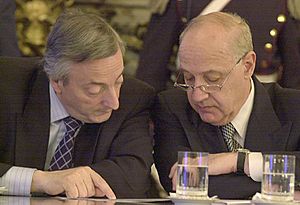
Kirchner's economic plan focused on having more exports than imports and a strong local currency. Argentina benefited from high prices for products like soybeans. His government also worked to rebuild Argentina's industries and public services.
In 2005, Argentina successfully negotiated a deal to reduce its national debt. Kirchner also repaid a large loan to the International Monetary Fund (IMF) using money from the Central Bank. The economy grew quickly during his time as president. He also increased social welfare programs and kept prices for public services like transportation and electricity low through government support.
Foreign Relations

Kirchner changed Argentina's foreign policy. He did not continue the very close relationship with the United States that existed in the 1990s. He also opposed a proposed free trade agreement for all of the Americas.
He worked to strengthen ties with other Latin American countries, especially the Mercosur trade group. He improved relations with Brazil and formed alliances with left-wing leaders like Hugo Chávez of Venezuela and Luiz Inácio Lula da Silva of Brazil.
Human Rights Focus

Kirchner made human rights a key part of his presidency. He supported groups that wanted to bring to justice military members involved in past human rights abuses during the "Dirty War" in the 1970s. He pushed for laws that had stopped these trials to be removed. In 2005, the Supreme Court agreed, allowing many cases to be reopened.
He also changed the policy on sending people to other countries for trials (extradition). Kirchner supported turning former detention centers into places to remember those who disappeared. The Mothers of the Plaza de Mayo, a famous human rights group, even held their final protest in 2006, saying that Kirchner was not their enemy.
After the Presidency
Néstor Kirchner did not run for reelection in 2007. Instead, his wife, Cristina Fernández de Kirchner, ran for president and won. He became the First Gentleman and remained a very important political figure during her term.
In 2007, he took part in Operation Emmanuel in Colombia, which aimed to free hostages held by the FARC group. The mission was not successful, but the hostages were later freed by the Colombian military.
Kirchner became president of the Justicialist Party in 2008. In 2009, he ran for a seat in the Argentine Chamber of Deputies for Buenos Aires Province but was defeated.
In 2010, Kirchner was chosen as the first Secretary General of the Union of South American Nations (UNASUR). He successfully helped to resolve a disagreement between Colombia and Venezuela.
Style and Political Ideas
Néstor Kirchner was often seen as a left-wing and progressive leader. He was known for his strong and determined style. He often used disagreements with other political groups or social forces to create clear choices for the public. This approach became a key part of his political style.
He aimed to gather political power and often used special laws that gave the president more control over the national budget. His party, the Front for Victory, grew to include many different groups. This helped him to have strong support in Congress and made it harder for opposition parties to challenge his government.
Kirchner was also known for being very hands-on in government. He often managed many tasks himself or gave them to trusted helpers, even if they were not high-ranking ministers. He also showed a strong nationalistic approach, especially regarding the Falkland Islands sovereignty dispute.
He was against the death penalty. After the execution of Saddam Hussein, Kirchner spoke out, calling for the end of capital punishment around the world.
Death
Néstor Kirchner died on 27 October 2010, at the age of 60. He was at home in El Calafate when he had a heart attack. He had undergone two heart procedures earlier that year. His death was a surprise to many Argentines.
His body was taken to the Casa Rosada, the presidential palace, for a state funeral. Thousands of people came to pay their respects, even in heavy rain. Cristina Kirchner stood by the coffin, and people brought candles, flags, and flowers. Many countries, including Brazil and Venezuela, declared days of mourning. Leaders from around the world, like Hugo Chávez and Luiz Inácio Lula da Silva, attended his funeral.
Legacy and Impact
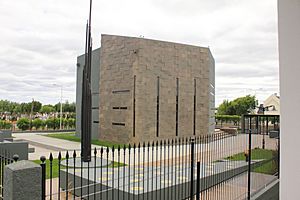
Néstor Kirchner's death had a big impact on Argentine politics. He was still a very influential figure. After his death, Cristina Fernández de Kirchner's popularity increased greatly, and she won reelection in 2011 by a large margin.
Many places, like streets, schools, and institutions, were renamed after "Néstor Kirchner" shortly after his death. For example, the "Bicentennial Cultural Centre" became the Néstor Kirchner Cultural Centre. However, some of these name changes were debated in different cities.
Honours and Awards
Foreign Honours
Honorary Degrees
 China: Fudan University honorary degree, 17 June 2004.
China: Fudan University honorary degree, 17 June 2004. Argentina: National University of Entre Ríos posthumous honorary degree, 16 December 2010.
Argentina: National University of Entre Ríos posthumous honorary degree, 16 December 2010. Argentina: National University of Lanús posthumous honorary degree, 20 December 2010.
Argentina: National University of Lanús posthumous honorary degree, 20 December 2010.
Images for kids
-
The Kirchners' net worth (this graph shows how their wealth changed over time).
See also
 In Spanish: Néstor Kirchner para niños
In Spanish: Néstor Kirchner para niños


